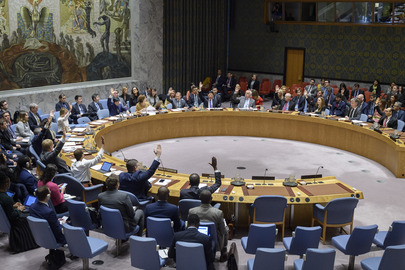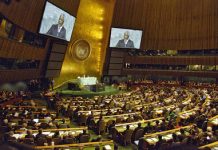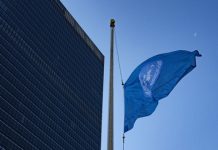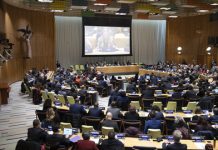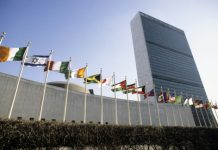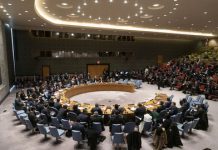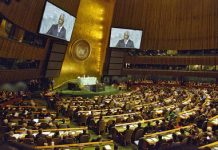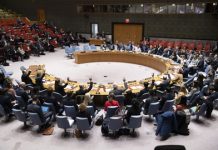These are the results of the ammunition from last nights’ attacks, or at least from the munitions which exploded.
At a briefing in New York, Paul Heslop, the UN Mine Action Service (UNMAS) advisor in Ukraine, described the impact of the unexploded ordnances which have contaminated large swaths of land in the country.
“Contaminated land is not just dangerous. It is lost hope, recovery and livelihood,” he said.
Since the start of Russia’s full-scale invasion of Ukraine in February 2022, this contamination has spread throughout the territory, making it impossible for residents to return home and farmers to cultivate crops. Children are often among the most vulnerable to unexploded ordnances.
UNMAS and its partners on the ground are working diligently to comb over this land and declare it safe for returning residents and agricultural cultivation.
Massive contamination, ‘real and perceived’
Millions of mines and unexploded ordnances are currently scattered throughout Ukraine. This makes it the most heavily contaminated country since the end of the Second World War, said Mr. Heslop.
UNMAS estimates that over 20 per cent of land — or 139,000 square kilometres — in Ukraine is contaminated by mines or unexploded ordnances.
Over six million people live in or around contaminated areas and over 800 casualties due to unexploded ordnances have been documented. This is the real contamination.
But Mr. Heslop noted that for every one square kilometre which is actually contaminated, there are 100 which are not. However, that does not mean that residents feel they can safely return to the land. This is the “perceived contamination” of unexploded ordnances.
UNMAS is working to identify which of the 139,000 square kilometres of potentially contaminated land is safe.
An Explosive Ordnance Disposal Specialist works in Ukraine to clear land of contamination from the war.
35,000 square kilometres declared safe
Two years ago, UNMAS estimated that 174,000 square kilometres in Ukraine were contaminated. Since then, 35,000 square kilometres have been declared safe, enabling residents to go back to their communities.
The process of demining contaminated land — either by removing unexploded ordnances or by scanning an area to declare it safe — is especially important for families reliant upon agriculture.
Since the start of the war, Ukraine’s agricultural sector has suffered $83.9 billion in losses, due in part to large swaths of agricultural land being contaminated with unexploded ordnances.
The Food and Agriculture Organization (FAO) has supported over 250,000 families through various programmes, including vouchers and seed distribution. They have also worked closely with UNMAS to clear agricultural land and return it to use.
‘Real progress’
UNMAS and its partners also have worked, over the last few years, to develop a system for demining which maximizes efficiency.
“Demining is an inherently inefficient process,” Mr. Helsop said.
After all, the most thorough option for demining is also the most time-consuming and expensive — having a person walk the land with a detector.
UNMAS alongside two dozen Ukrainian Government entities, have been working to implement satellite and artificial intelligence technology to make demining more time and cost effective.
“What we need to do is make sure the investment that is being made today …continues to deliver results and [is] enhanced moving forward,” he said.
The problem as an ‘elephant’
Mr. Helsop compared demining in Ukraine to an elephant, calling upon humanitarian agencies and donors to think about this large problem comprehensively.
He said that demining efforts are still being hampered by a lack of cohesion among groups on the ground, and by funding and personnel shortages. Donors have already committed $1 billion to fund demining efforts in Ukraine, but he said that the entire project would cost many billions.
He also reiterated the necessity of doing it, not only for the people in Ukraine whose livelihoods have been disrupted by contaminated land, but also for the world which has witnessed increased food and energy costs as a result of decreased agricultural production in the country.
“We know how to do it… but we need the resources to do it and it’s going to be a slow and potentially dangerous process,” he said. “But if we get it right, we will bring down global food and energy prices.”
Source of original article: United Nations (news.un.org). Photo credit: UN. The content of this article does not necessarily reflect the views or opinion of Global Diaspora News (www.globaldiasporanews.com).
To submit your press release: (https://www.globaldiasporanews.com/pr).
To advertise on Global Diaspora News: (www.globaldiasporanews.com/ads).
Sign up to Global Diaspora News newsletter (https://www.globaldiasporanews.com/newsletter/) to start receiving updates and opportunities directly in your email inbox for free.


